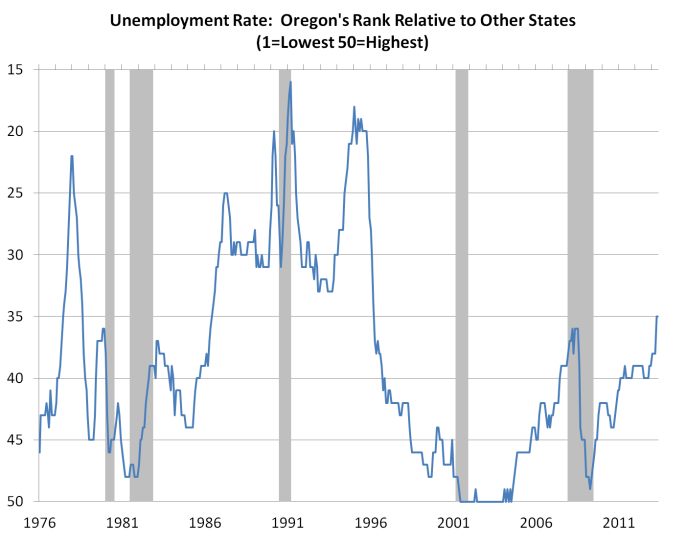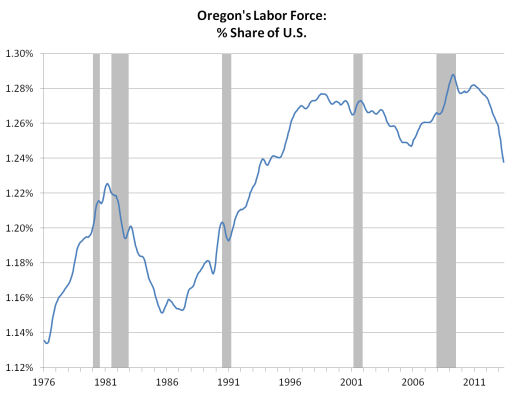![]()
Oregon unemployment rate: 35th out of 50 aint bad
By Josh Lehner
Oregon Office of Economic Analysis Blog.
The news that Oregon’s unemployment rate had fallen below the symbolic rate of 8% was met with widespread applause this week. Indeed, the worst of the economic downturn does appear to be behind us: http://www.oregonlive.com/opinion/index.ssf/2013/06/may_jobs_report_shows_progress.html#incart_river
Unfortunately, the improvement in job opportunities has not yet been accompanied by an associated increase in the number of available workers. This is of particular concern in Oregon, where healthy labor force growth and the ability to attract skilled workers to the state arguably represent our strongest comparative advantage relative to other regional economies.
Currently, only fifteen states exhibit unemployment rates higher than that of Oregon. Although ranking 35th sounds bad, it is the best Oregon’s unemployment rate has looked relative to other states in 20 years. Not since the emergence of Oregon’s technology industries, when a flood of skilled workers and high-paying jobs were migrating to the state, has Oregon’s unemployment rate ranked as high as a measly 35th.
Why does Oregon’s rate of unemployment rank persistently high relative to other states? The answer lies in the nature of our workforce and the mix of industries in the state. In particular, many of Oregon’s businesses, including resource and construction firms, have strong seasonal patterns to their hiring. As such, Oregon has a surplus of labor during the winter months. Furthermore, Oregon’s role as a manufacturing hub (with a largely non-unionized workforce) also exposes the state to higher trend rates of unemployment.
In addition to our mix of industries, Oregon also has a relatively young, flexible workforce that does not easily become discouraged when jobs are scarce. Looking past the stereotype of Portland as a place where young people go to retire, Oregon’s labor force growth has outstripped that in other states ever since the timber downturn of the 1980’s, with particularly strong growth throughout the decade of the 1990’s. Given this strong labor force growth, Oregon would have needed to add 30% more jobs than the typical state in order to keep its unemployment rate ranking stable over this period.
It is very troubling that Oregon’s traditionally strong labor force growth has yet to return despite relatively more job opportunities. Over the past two years, Oregon’s labor force growth has trailed far behind that seen in other states. As such, the recent decline in the statewide unemployment rate overstates the improvement in underlying labor markets.
Some of the weakness in Oregon’s labor force growth can be traced to dysfunctional housing markets. Many potential migrant households from California and elsewhere have been trapped in their houses unable to move, due to bad loans or a glut of housing supply in their area.
It is hoped that with both housing and job markets becoming tighter, Oregon’s traditional migration advantage will return going forward. In the absence of such a rebound in labor force growth, the pace of Oregon’s economic recovery will continue to disappoint.
Disclaimer: Articles featured on Oregon Report are the creation, responsibility and opinion of the authoring individual or organization which is featured at the top of every article.



